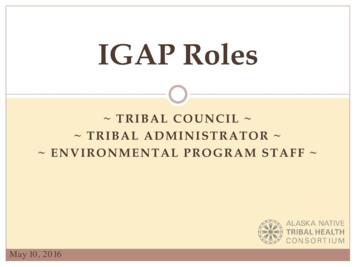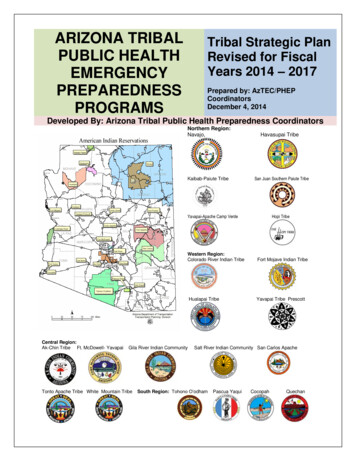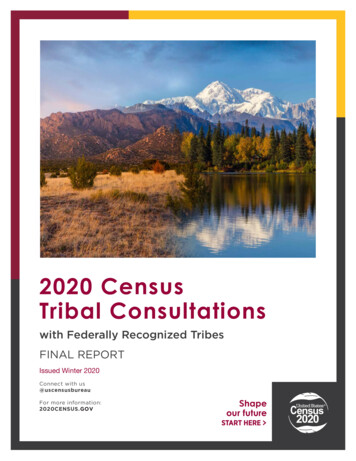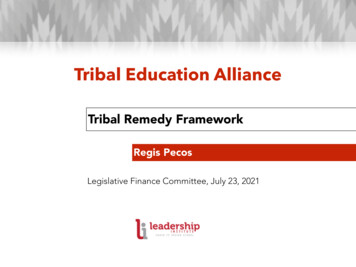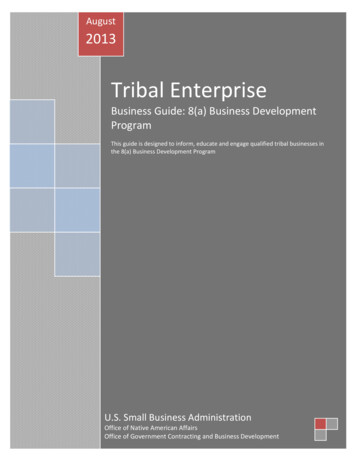
Transcription
August2013Tribal EnterpriseBusiness Guide: 8(a) Business DevelopmentProgramThis guide is designed to inform, educate and engage qualified tribal businesses inthe 8(a) Business Development ProgramU.S. Small Business AdministrationOffice of Native American AffairsOffice of Government Contracting and Business Development
Tribal EnterpriseBusiness Guide:8(a) Business Development ProgramOffice of Native American AffairsOffice of Government Contracting & Business DevelopmentJuly 2013This is about tribally owned businesses winning federal contracts.Welcome to “Tribal Enterprise” – a business guide to the 8(a) Business Development Program.NOTE:This supplemental workbook tracks the slides and narrativePage2contained in the online training module, Tribal Enterprise - Business Guide:8(a) Business Development Program. The online version of the trainingguide, with audio can be accessed at: www.sba.gov/gcclassroom. For theuser’s convenience, all hyperlinks contained in the copied slides are includedas links at the end of the workbook.
Introduction 8(a) Business Development Program is designed to assist socially andeconomically disadvantaged small businesses, including tribally ownedbusinessesDesigned to inform, educate and engage qualified businesses in the 8(a)programThe 8(a) program is a business development program designed to assist socially and economicallydisadvantaged small businesses, including tribally owned enterprises.This guide is designed to inform, educate and engage qualified tribal businesses in the 8(a) program.Page3Notes
Course ContentsTribal Enterprise1.2.3.4.5.6.7.Tribally Owned Businesses8(a) Program Purpose & SummaryHow the Program WorksEligibility Requirements for Tribal EnterprisesApplication ProcessKey Questions & AnswersResources and AssistanceThe training module provides an overview of the 8(a) program, including a discussion about triballyowned businesses, a description of the program’s purpose, how it works, tribal eligibility requirements,the application process, key questions and answers and important resources.In addition many of the slides include highlighted boxes with specific FAR and CFR regulatory referencesto help users easily access more information about the content in the slides.Page4Also, the course is designed so that you can easily go to, leave or return to any section of the course, atany time.
Tribally Owned Businesses What is a tribally owned business?– any business concern that is at least 51% owned by an Indian tribe– Indian tribe means any Indian tribe, band, nation or other organized group orcommunity of Indians, including any ANC, which is recognized as eligible forthe special programs and services provided by the United States to Indiansbecause of their status as Indians or is recognized as such by the State inwhich the tribe, band, nation or community resides13 CFR 124.3Tribal EnterpriseBut first, what is a tribally owned business or concern? For purposes in this training module, the termstribally owned business or tribally owned enterprise are used interchangeably with the term triballyowned concern.As defined in federal regulations, a tribally owned business (concern) means any business (concern) thatis at least 51% owned by an Indian tribe. An Indian tribe is any Indian tribe, band, nation or otherorganized group or community of Indians, including any ANC, which is recognized as eligible for thespecial programs and services provided by the United States to Indians because of their status as Indiansor is recognized as such by the State in which the tribe, band, nation or community resides.Page5Notes
Business Development GrowthTribally Owned BusinessesBusiness Development GrowthInitiate successful businessdevelopment projects.Economic DevelopmentBuild capacity to identify, select, andmanage opportunities that help achievethe community’s vision.Nation BuildingBuild a strong foundational base for economicdevelopment.Adopted Cornell, S.,& Kalt, J.P. (2007)Tribal EnterpriseThe 8(a) program is a tool, a business development tool that may fit within the economic developmentvision of the tribe or the tribal entities that make up the tribe.With that said, successful business development within a tribe may be enhanced with a well-definedeconomic development framework and a strong foundational base of capabilities, strategies andsupporting policies.At the base sits nation building. A strong, effective, self-driven nation serves as the foundation tosupport all productive activity. Resting above it, is economic development. In this level, a nation buildsthe capacity to identify, select and manage the community’s endowment of resources and talent thathelp achieve the community’s vision.Page6At the top is business development growth. Here tribal entities make critical decisions on starting andgrowing their businesses. The 8(a) program is but one tool that may help support business developmentgrowth.
Framework for Business Development GrowthTribally Owned Businesses Assess– What we know Strategic choices Capabilities– Identify opportunities– Alignment and delivery Action Mobilization– Adapting and learning– Willingness to lead changeTribal EnterpriseAchieving business growth requires a plan. A well thought out plan.As such, a tribe should have a good understanding of where it is today, where it has been and where itwants to go. Five steps can be applied to build a planning framework. First, gather what you know andassess your current circumstances. Second, identify opportunities and make strategic choices. Applyingto the 8(a) program, for instance, may be one of those choices.Third, understand your tribal capabilities and align skills with what your tribe can successfully deliver.Fourth, identify and manage actions and lastly, but most importantly, mobilize change.Page7Notes
Structural OptionsTribally Owned BusinessesTribeHolding Company / Eco Dev8(a)Firm8(a)FirmTribal GovernmentFunctionsTribal Business Structure HandbookTribal Enterprise Developer’s GuidesTribal EnterpriseThe 8(a) program is a tool. And, a tribe may have more than one 8(a) tribal enterprise.It is important for a tribe to understand how it can be optimally structured so it can be positioned forbusiness development growth. This slide shows one structural option, with two affiliated 8(a) firms.There are other options.At your convenience, review the hyperlinked guides to better understand how a tribe can be positionedfor growth.Page8Notes
Reflection Tribally Owned Businesses Does your tribe have a strong foundational base for economicdevelopment?Has tribal leadership considered ways the 8(a) program can be used as abusiness development tool for your tribe?Is your tribe structurally positioned for optimal business developmentgrowth?Tribal EnterpriseReflection Does your tribe have a strong foundational base for economic development? Has tribal leadershipconsidered ways the 8(a) program can be used as a business development tool? Is your tribestructurally positioned for optimal business development growth?Page9Notes
Overview & SummaryTribal EnterpriseProgram overview and summary.Page10Notes
Program Purpose8(a) Program & Summary Help small disadvantaged businesses, including tribally owned businessescompete in the marketplaceProvide business development supportPrepare qualifying entities for procurement and other businessopportunities13 CFR 124.1Tribal EnterpriseThe 8(a) Program -- named for Section 8(a) of the Small Business Act – is designed to assist smalldisadvantaged businesses, including tribally owned businesses to compete in the marketplace. It is alsodesigned to assist such entities in gaining access to federal and private procurement markets.The primary focus of the program is to provide business development support, such as mentoring,procurement assistance, business counseling, training, financial assistance, surety bonding and othermanagement and technical assistance to qualified firms. The ultimate objective, however, is to preparesmall disadvantaged firms for procurement and other business opportunities.Page11Through the award of sole source and set-aside contracts, the 8(a) program provides market access andgrowth for qualified tribal enterprises.
American Indian -- 8(a) Perspective8(a) Program & Summary 8(a) program is a business development tool for American Indian tribesFederal agencies have strong incentives to contract with tribal concernsTribes do have special procurement privileges – an important perspectiveis that often times proceeds from tribally owned companies are used tobenefit the entire tribal membership, rather than individual ownersTribal EnterpriseThe program is a business development tool that offers opportunities for American Indian tribes.Under the 8(a) program, Congress granted tribes with unique rights in the federal procurement process.These rights provide federal agencies with strong incentives to contract with tribal enterprises.Page12Tribes do have special procurement privileges. There are many reasons for this. However, an importantperspective is that often times the proceeds from tribally owned companies are used for the benefit ofthe entire tribal membership, rather than individual owners. Tribes use these proceeds to build, sustainand operate their communities – for the betterment of education, health care, public works and othercommunity sustaining activities.
Regulatory Guidance8(a) Program & SummaryThe 8(a) Business Development Program: Established by:– Section 8(a) of the Small Business Act of 1953 Governed by:– 13 CFR 124.100–124.704 (Subpart A)– FAR Part 19.800–19.812 Specific References to Tribally Owned Businesses:–––––13 CFR 124.3 -- Definitions13 CFR 124.103 -- Who is Socially disadvantaged?13 CFR 124.105-106 -- Eligibility13 CFR 124.109 -- Applying to the 8(a) program13 CFR 124.112 -- Business criteria to remain eligibleTribal EnterpriseThe 8(a) program was established by Section 8(a) of the Small Business Act.It is primarily governed by 13 CFR 124 Subpart A and FAR Parts 19.8 – 19.812. Specific references totribally owned businesses are also noted in the slide.Page13Notes
Key Program Objectives8(a) Program & Summary “Promote the business development of small business concerns ownedand controlled by socially and economically disadvantaged individuals ”“Promote the competitive viability of such concerns ”“Clarify and expand the program for procurement by the United States ”Tribal EnterpriseAs articulated in statute and regulations, the key objectives of the 8(a) program are to promote businessdevelopment of small business concerns owned and controlled by socially and economicallydisadvantaged individuals; to promote the competitive viability of such concerns; and to use the tools ofthe program to help qualified small disadvantaged firms benefit from federal procurementopportunities.Qualifying tribally owned businesses can benefit from these key program objectives.Page14Notes
Term of Participation8(a) Program & Summary Maximum 9 year participation in the program, beginning from the date ofSBA approvalFirst 4 years are considered the developmental stageLast 5 years are considered the transitional stageContinuation in the program is dependent on:– Remaining eligible as a socially and economically disadvantaged firm (includesall applicable requirements)– Staying in compliance with the 8(a) BD participation agreement13 CFR 124.2Tribal EnterpriseParticipation in the 8(a) program is limited to 9 years, beginning from the date a firm is approved by theSBA as a certified 8(a) Business Development firm.The first four years in the program are considered the developmental stage. The last five years in theprogram are considered the transitional stage.Page15Continuation in the program, in both the developmental and transitional stages, is dependent on thefirm’s continuing eligibility as a socially and economically disadvantaged – owned and operated – firmand that the firm continues to be in compliance with the 8(a) business development agreement.
Summary Requirements and Goals8(a) Program & Summary Overall goal for 8(a) firms is to graduate from the program and thrive in acompetitive business environmentRequirements:– Maintain a balance between commercial and government business– SBA district offices monitor and measure the progress of participating firms Annual review Business planning Systematic evaluationsTribal EnterpriseThe 8(a) program is a business development program. As such, the overall goal for 8(a) firms is tograduate from the program and go-on to thrive in a competitive business environment. There areseveral requirements in place to help firms achieve this goal.Firms must maintain a balance between their commercial and government business.In addition, SBA district offices monitor and measure the progress of participating 8(a) firms. It does thisthrough annual reviews, business planning collaboration and systematic evaluations.Page16Notes
Reflection 8(a) Program & Summary Is the purpose of the 8(a) program aligned with the goals and objectives ofyour tribe?Is your tribe and related tribal businesses positioned to take advantage ofopportunities available through the 8(a) program?Tribal EnterpriseReflection Is the purpose of the 8(a) program aligned with the goals and objectives of your tribe? Is your tribe andrelated tribal businesses positioned to take advantage of opportunities available through the 8(a)program?Page17Notes
How the 8(a)Program WorksTribal EnterpriseHow the 8(a) program works.Page18Notes
Driven by Several Key ComponentsHow the 8(a) Program Works SBA’s role– Business development assistance– Business development support– Contract opportunities Role of the tribal 8(a) program participant––––Capitalize on available business development assistance and supportLearn about government buying needsMarket to the governmentSubmit information annually to the SBA to prove eligibilityTribal EnterpriseThe program is driven by several key components. SBA plays a pivotal role, but the core of the programis focused on business development assistance, business development support, finding contractopportunities and marketing.Page19The most important role, however, is played by 8(a) firms themselves. Each of these components isexplained in the following sections.
SBA’s RoleHow the 8(a) Program Works Program policy guidanceReview and certify eligible clientsAssign SBA personnel, Business Opportunity Specialists, to 8(a)participating firmsProvide business development assistanceHelp identify contract opportunities for 8(a) participating entitiesReview progress of 8(a) certified businesses and tribal concernsTribal EnterpriseAs the administrator of the program, SBA provides program policy guidance, reviews and certifieseligible clients, assigns SBA personnel -- Business Opportunity Specialists -- to approved 8(a) entities,provides business development assistance, helps in identifying potential contract opportunities andreviews the progress of participating 8(a) concerns.Page20SBA’s role is to build a strong resource-rich program -- that helps 8(a) tribal enterprises to become andremain competitive in the economic mainstream.
Business Development AssistanceHow the 8(a) Program Works Business counseling and mentoringOnline and traditional trainingSurety bond guaranteesContract marketing guidanceAble to acquire federal government surplus propertyOther management and technical assistance13 CFR 124.404-124.405Tribal EnterpriseAiding 8(a) tribal enterprises with business development assistance is core to the program. Thisassistance takes many forms, but includes, business counseling and mentoring; online and traditionaltraining; surety bond guarantees; contract marketing guidance; acquiring federal government surplusproperty; and, other forms of management and technical assistance.Competitive strength comes from knowledge, financial support and technical assistance – all of whichcan be gained through SBA’s business development initiatives.Page21Notes
Business Development SupportHow the 8(a) Program Works Helping firms:–––– register in the System for Award Management (SAM)find contract opportunitiesmaintain a current business plan with a procurement strategyand other supportWorking with agencies and prime contractors to direct contracts to smallfirmsAssigning Business Opportunity Specialists(BOS)s to work individually withparticipating 8(a) firmsTribal EnterpriseProviding management, technical and financial assistance is one aspect of the program. Another keydimension is providing business development support to 8(a) clients.This SBA support is varied and can include: helping 8(a) program clients register in the System for AwardManagement or SAM --- which is a national database of firms seeking to do business with the federalgovernment as well as prime contractors. SBA will also help firms to understand and use governmenttools to find contract opportunities, assists clients in developing and maintaining a current business planwith a defined procurement strategy, and provides assistance in many other ways. This assistance canbe beneficial to a tribal business.Importantly, SBA also works with federal agencies and prime contractors ---- encouraging them to setaside, breakout or otherwise make contracts available to 8(a) and other small firms. In other words, SBAmarkets the technical capabilities of small businesses to federal buying entities.Page22In addition, each 8(a) firm is assigned a Business Opportunity Specialist by the SBA. The assignedspecialist helps guide the 8(a) business during its tenure in the program.
Contract OpportunitiesHow the 8(a) Program Works SBA staff and Procurement Center Representatives (PCRs) work closelywith government and private organizations to identify procurementopportunities for small firmsGovernment-wide procurement goals that benefit small businesses– 23% -- Overall small business goal– 5% -- Small disadvantaged businesses– 5% -- Women owned small businesses– 3% -- Certified HUBZone firms– 3% -- Service-disabled veteran-owned small businessesTribal EnterpriseThe federal government buys in excess of 600 billion dollars in goods and services each year.Government-wide procurement goals help define another aspect of the 8(a) program. Such goalsestablish procurement targets for agencies that benefit small disadvantaged businesses and other smallfirms.SBA personnel, specifically Procurement Center Representatives, work closely with government andprivate organizations to identify procurement opportunities for small businesses and to help targetspecific acquisitions for 8(a) participating firms.In addition, government policy and SBA staff encourage federal agencies to meet or exceed annual smallbusiness procurement goals. The current government-wide goal for prime and subcontracts to smalldisadvantaged businesses is 5%. Overall, however, the government-wide small business goal for allprime contracts is 23%.Page23Other government-wide procurement goals include: 5 percent of prime and subcontracts for womenowned small businesses; 3 percent of prime and subcontracts for Hubzone businesses and 3 percent ofprime and subcontracts for service-disabled veteran-owned small businesses.
Role of 8(a) Tribal BusinessesHow the 8(a) Program Works SBA opens the door .8(a) client firms must be competitive and market themselvescompetitivelySuccessful 8(a)tribal firms capitalize on available business developmentresources, educate themselves on government buying needs, and marketthemselves based on skills and ability to meet such needsTribal EnterpriseFinally, in describing how the program works, the most important role is played by the 8(a) firms,themselves.SBA may be able to open some doors, but it is up to the tribal 8(a) firms in the program to becompetitive and to market themselves effectively.It’s all about preparation and self-marketing. Successful 8(a) firms capitalize on available businessdevelopment resources, educate themselves on government and corporate buying needs, and marketthemselves based on their skills and ability to support the procurement needs of multiple organizations.Page24Notes
Reflection How the 8(a) Program Works Can the 8(a) program be used successfully by your tribe as a businessdevelopment tool?How can this be accomplished?What specific steps should your tribe take to make this happen?Tribal EnterpriseReflection Can the 8(a) program be used successfully by your tribe as a business development tool? How can thisbe accomplished? Importantly, what specific steps should your tribe take to make this happen?Page25Notes
8(a) Program Eligibilityfor Tribal EnterprisesTribal EnterpriseProgram eligibility requirements for tribally owned enterprises.Page26Notes
Eligibility – Tribally Owned Businesses8(a) Program Eligibility Special rulesTribal eligibilityBusiness eligibility13 CFR 124.109Tribal EnterpriseEligibility for the 8(a) program is uniquely defined for tribally owned businesses. As such, there arespecial rules and unique tribal and business eligibility requirements.Page27Notes
Special Rules8(a) Program Eligibility Special rules– Initial 8(a) eligibility --- 13 CFR 124.109– Remaining in the 8(a) program as a participant --- 13 CFR 124.11213 CFR 109(a)Tribal EnterpriseSpecial rules apply to tribal enterprises regarding both initial 8(a) program eligibility and eligibility toremain in the 8(a) program as a participant.Page28Notes
Tribal Eligibility8(a) Program Eligibility Social disadvantageEconomic disadvantageRequired forms and documents13 CFR 109(b)Tribal EnterpriseTribal eligibility in the program requires specific evidence of social and economic disadvantage. It alsorequires specific forms and documents to be submitted at the time of application.Page29Notes
Social Disadvantage8(a) Program Eligibility – Tribal Eligibility An Indian tribe as defined in 13 CFR 124.3 is considered to be sociallydisadvantaged“An Indian tribe means any Indian tribe, band nation or other organized group or communityof Indians, including any ANC, which is recognized as eligible for the special programs andservices provided by the U.S. to Indians because of their status as Indians, or is recognized assuch by the state in which the tribe, band, nation, group or community resides”13 CFR 124.3Tribal EnterpriseRegarding social disadvantage and for the purposes of the 8(a) program, an Indian tribe -- as defined in13 CFR 124.3 -- is considered to be socially disadvantaged.Page30Notes
Economic Disadvantage8(a) Program Eligibility – Tribal Eligibility Indian tribe must demonstrate to the SBA that the tribe itself iseconomically disadvantaged–––––––Number of tribal membersPresent tribal unemployment ratePer capita income of tribal membersPercentage of local Indian population below the poverty levelTribe’s access to capitalTribal assetsList of wholly or partially owned tribal enterprises or affiliates13 CFR 124.109(b)(2)Tribal EnterpriseRegarding economic disadvantage, 8(a) program eligibility requirements require that the tribalapplicant’s tribe, demonstrate to the SBA that it is economically disadvantaged. To do this, SBA willconsider a number of factors, including: number of tribal members; present tribal unemployment rate; per capita income of tribal members, excluding judgment awards; percentage of the local Indian population below the poverty level; tribe’s access to capital; tribal assets as disclosed in a current tribal financial statement; and the aggregate of wholly or partially owned tribal enterprises or affiliates.Page31Importantly, once an Indian tribe establishes that it is economically disadvantaged in connection withthe application for one tribally-owned firm, it does not have to reestablish such status in order to haveother businesses that it owns, certified for 8(a) program participation, unless specifically requested todo so by the SBA.
Required Forms and Documents8(a) Program Eligibility – Tribal Eligibility Tribal applicant is required to submit all of the same documents generallyrequired by all other 8(a) applicantsOther tribal specific documents required include:– Copy of tribal governing documents– Evidence of tribal recognition for special programs and services– Copies of articles of incorporation and bylaws as filed with the organizing or charteringauthority, or similar documents needed to establish and govern a non-corporate legalentity– Documents to show tribe’s economically disadvantaged status13 CFR 124.109(b)(3)Tribal EnterpriseA tribal applicant is required to submit all of the same documents generally required by all other 8(a)applicants.However, a tribally owned business is also required to submit additional tribal specific documentation,including: a copy of the tribal governing documents; evidence of tribal recognition for special U.S.programs and services; copies of articles of incorporation and bylaws as filed with the organizing orchartering authority, or similar documents needed to establish and govern a non-corporate legal entity;and, documents to demonstrate the tribe’s economically disadvantaged status.Page32Notes
Tribal Business Eligibility8(a) Program Eligibility Legal business entity organized for profitSizeOwnershipControl and managementIndividual eligibility limitationPotential for success13 CFR 124.109(c)Tribal EnterprisePage33Besides tribal eligibility requirements, there are business eligibility requirements for the 8(a) programthat must be complied with as well. These requirements focus on the legal structure of the tribalbusiness, the size of the concern, ownership rights, control and management of the enterprise,individual eligibility limitation and the potential for success of the tribal enterprise.
Legal Business Entity Organized for Profit8(a) Program Eligibility – Tribal Business Eligibility Applicant must be a separate and distinct legal entity organized by thetribe, federal or state authoritiesGovernance documentation must express sovereign immunity language,or “sue and be sued” clause which designates U.S. federal courts to beamong the courts of competent jurisdiction for all matters relating toSBA's programs, including, but not limited to 8(a) program participation,loans and contract performanceTribal enterprise must be organized for profit and the tribe must possesseconomic development powers in the tribe’s governing documents13 CFR 124.109(c)1Tribal EnterpriseThe tribal 8(a) applicant must be a separate and distinct legal entity organized or chartered by the tribe,federal or state authorities. The tribal firm’s articles of incorporation, partnership agreement or limitedliability company articles of organization must contain sovereign immunity waiver language, or a “sueand be sued” clause which designates U.S. federal courts to be among the courts of competentjurisdiction for all matters relating to SBA's programs.Importantly, the waiver of sovereign immunity language may require special board or tribal governmentapproval, depending on the tribal firm’s structure. If the waiver language, however is not included inthe documentation, the firm will be denied admission into the 8(a) program.Page34Also, the tribal enterprise must be organized for profit, and the tribe must possess economicdevelopment powers in the tribe's governing documents.
Size8(a) Program Eligibility – Tribal Business Eligibility Tribally owned applicant must qualify as a small business and certify assuch to the SBA, pursuant to the provisions in 13 CFR 121In determining the small business size standard, the Indian tribe – orwholly owned business of the tribe – will be determined independentlywithout regard to its affiliation with the tribe, any entity of the tribalgovernment or any other business enterprise owned by the tribe13 CFR 124.109(c)2Tribal EnterpriseBusiness size matters. A tribally owned applicant must qualify as a small business concern as defined forpurposes in 13 CFR 121. The particular size standard to be applied is based on the primary industryclassification or NAICS code of the applicant concern.Also, in determining the size of a small business owned by an Indian tribe, or a wholly owned businessentity of the tribe, the firm’s size shall be determined independently without regard to its affiliation withthe tribe, any entity of the tribal government, or any other business enterprise owned by the tribe,unless the SBA Administrator determines that one or more such tribally-owned businesses haveobtained, or are likely to obtain, a substantial unfair competitive advantage within an industry category.Page35Notes
Ownership8(a) Program Eligibility – Tribal Business Eligibility For corporate entities, a tribe must unconditionally own at least 51percent of the voting stock and at least 51 percent of the aggregate of allclasses of stockFor non-corporate entities, a tribe must unconditionally own at least 51percent interestTribe may not own 51% or more of another firm which, either at the timeof application or within the previous two years, has been operating in the8(a) program under the same primary NAICS code as the applicant13 CFR 124.109(c)3Tribal EnterpriseWith regards to ownership, a tribe must unconditionally own at least 51 percent of the ownership orstock of the business concern.A tribe may not own 51% or more of another firm which, either at the time of application or within theprevious two years, has been operating in the 8(a) program under the same primary NAICS code as theapplicant. However, a tribe may own a participant or other applicant that conducts or will conductsecondary business in the 8(a) program under the NAICS code which is the primary NAICS code of theapplicant business.In addition, once an applicant is admitted to the 8(a) program, it may not receive an 8(a) sole sourcecontract that is a follow-
Tribal Enterprise . Business Guide: 8(a) Business Development Program . This guide is designed to inform, educate and engage qualified tribal businesses in the 8(a) Business Development Program . August 2013. U.S. Small Business Administration . Office of Native American Affairs . Office of Government Contracting and Business Development
